Contents
- USCIRF downgrades India in 2020 list
- Niti Aayog questions IEP’s terror ranking of India
- Health Ministry does a U-turn on plasma therapy
- BRICS should help entrepreneurs: India
- $1.5 billion ADB loan to fund COVID-19 emergency response
- No improvement in Ganga water quality after lockdown
- Animal poaching registers a sharp increase during lockdown
USCIRF DOWNGRADES INDIA IN 2020 LIST
Focus: GS-II International Relations, Social Justice
Why in news?
The U.S. Commission on International Religious Freedom (USCIRF) has downgraded India to the lowest ranking, “countries of particular concern” (CPC) in its 2020 report.
India was categorised as a “Tier 2 country” in last year’s listing.
This is the first time since 2004 that India has been placed in this category.
The commission also recommended that the U.S. government take stringent action against India under the “International Religious Freedom Act” (IRFA).
Details of what USCIRF claimed
- The report, released in Washington by the federal government commission that functions as an advisory body, placed India alongside countries, including China, North Korea, Saudi Arabia and Pakistan.
- The commission noted in its report, which included specific concerns about the Citizenship Amendment Act, the proposed National Register for Citizens, anti-conversion laws and the situation in Jammu and Kashmir.
- The national government used its strengthened parliamentary majority to institute national-level policies violating religious freedom across India, especially for Muslims.
- The panel said that the CPC designation was also recommended because “national and various State governments also allowed nationwide campaigns of harassment and violence against religious minorities to continue with impunity, and engaged in and tolerated hate speech and incitement to violence against them”.
- Under IRFA, the USCIRF called on the administration to “impose targeted sanctions on Indian government agencies and officials responsible for severe violations of religious freedom by freezing those individuals’ assets and/or barring their entry into the United States under human rights-related financial and visa authorities, citing specific religious freedom violations”.
India’s Reaction
- The Centre reacted sharply to the USCIRF report on 28th April 2020, terming it “biased and tendentious” and rejected its observations.
- The Centre noted that the USCIRF biased and tendentious comments against India are not new. But on this occasion, its misrepresentation has reached new levels.
- The Ministry of External Affairs had rejected the USCIRF statement as neither “accurate nor warranted” and questioned the body’s “locus standi” in India’s internal affairs.
USCIRF
- The United States Commission on International Religious Freedom (USCIRF) is a U.S. federal government commission created by the International Religious Freedom Act (IRFA) of 1998.
- USCIRF Commissioners are appointed by the President and the leadership of both political parties in the Senate and the House of Representatives.
- USCIRF’s principal responsibilities are to review the facts and circumstances of violations of religious freedom internationally and to make policy recommendations to the President, the Secretary of State, and the Congress.
- In practice, the USCIRF has little teeth in implementation, but acts as a conscience-keeper for the two branches in the US government – the legislature and the executive.
- The USCIRF is mandated to “monitor the universal right to freedom of religion or belief abroad — however, NOT in the U.S.
IRFA
The International Religious Freedom Act of 1998 was passed to promote religious freedom as a foreign policy of the United States, to promote greater religious freedom in countries which engage in or tolerate violations of religious freedom, and to advocate on the behalf of individuals persecuted for their religious beliefs and activities in foreign countries.
International Religious Freedom report
- USCIRF releases International Religious Freedom report annually.
- The Report consists of country-wise chapters.
- This report includes policy recommendations to the U.S. government based on the report’s evaluation of the facts and circumstances of religious freedom violations worldwide.
NITI AAYOG QUESTIONS IEP’S TERROR RANKING OF INDIA
Focus: GS-II Governance, International Relations
Why in news?
- A report compiled by Niti Aayog has questioned the methodology adopted by an Australian based institute – Institute for Economics and Peace (IEP)- to rank India as the seventh worst terrorism affected country.
- This IEP’s report has put India ahead of conflict-ridden countries such as the Democratic Republic of Congo, South Sudan, Sudan, Burkina Faso, Palestine and Lebanon.
- India has moved to the seventh position from the previous year’s eighth in the annual Global Terrorism Index (GTI) 2019.
- The countries ahead of India (meaning, affected more than India by terrorism) are Afghanistan, Iraq, Nigeria, Syria, Pakistan and Somalia.
- The Cabinet Secretariat asked Niti Aayog to track 32 such global indices to see how they could help drive reforms and growth.
Issues with the report and the Institute that generated it
- The Methodology used was questioned because it shows India to be affected more by terrorism than countries that are in a crisis being ridden with terrorism like Sudan.
- The report also questions the opaque funding of the Institute for Economics and Peace (IEP).
- It is also surprising that an organization is able to annually collect, meaningfully analyse and disseminate data about 163 countries in the Global Terrorism and Peace Indices and provide country wise national peace reports with just 24 staff members and 6 volunteers.
- While the GTD claims to analyse more than two million open source media reports published each day, it lacks any mechanism to engage with Governments or to further classify and verify such open source media reports through Government databases in any of the 163 countries it covers.
- The large diversity in definitions of terrorism amongst countries, and the lack of a universally accepted definition of terrorism, including in the Comprehensive Convention on International Terrorism pending in the UN General Assembly since 2014, leads to a great deal of ambiguity in calculating and understanding GTI reports.
- IEP’s economic impact of terrorism model does not account for costs for countering violent extremism and long-term economic impacts on business activity, production and investment.
Significance and Impact of this report
- The GTI report issued by the IEP is based primarily on the Global Terrorism Database (GTD) collated by the National Consortium for the Study of Terrorism and Responses to Terrorism (START) at the University of Maryland, besides other sources.
- GTI scores are directly used in the Global Peace Index, the Global Slavery Report published by the Walk Free Foundation, and indirectly used in computing country scores in the World Economic Forum’s Travel and Tourism Competitiveness and Global Competitiveness Indices and compilation of Safe Cities Index by the Economist Intelligence Unit.
- An official said the positioning in the global indices impacted investments and other opportunities.
Conclusion of the report against IEP’s Index
The absence of a robust data collection and analysis methodology, and any engagement with Governments facing the scourge of terrorism, means that the Global Terrorism Index has low direct value for policymakers and cannot be used as an aid to understand and alleviate challenges to countries from domestic and cross border terrorism.
Global Terrorism Index 2019
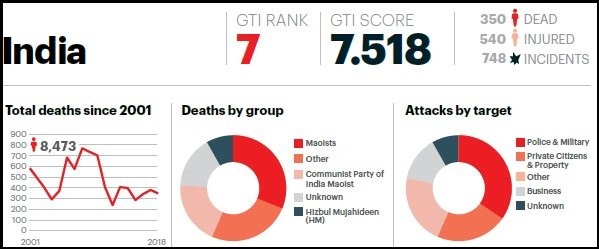
Terror groups in India
- SATP (South Asia Terrorism Portal) has listed 180 terrorist groups that have operated within India over the last 20 years, many of them co-listed as transnational terror networks operating in or from neighboring South Asian countries such as Bangladesh, Nepal and Pakistan.
- Of these, 38 are on the current list of terrorist-organisations banned by India under its First Schedule of the UA(P) Act, 1967.
HEALTH MINISTRY DOES A U-TURN ON PLASMA THERAPY
Focus: GS-III Science and Technology
Why in news?
- Plasma therapy is not an approved treatment for COVID-19 and is only one of the several therapies which is being explored currently, the Health Ministry said on 28th April 2020, adding that the therapy is still at an experimental stage and the Indian Council for Medical Research (ICMR) is currently studying its efficacy.
- The Health Ministry statement comes days after the Drug Controller-General of India gave its go-ahead to a proposal by the ICMR for the clinical trial of convalescent plasma therapy in COVID-19 patients as per the protocol developed by ICMR.
- Till the ICMR concludes its study and a robust scientific proof is available, plasma therapy should be used only for research or trial purpose.
Plasma Therapy in the past
- Plasma treatment is done by taking blood plasma from a cured COVID-19 patient to treat positive cases to effectively strengthen the immune system.
- In 2014 convalescent plasma, collected from patients who had recovered from Ebola virus disease, was recommended by the World Health Organisation (WHO) as an empirical treatment during the outbreak.
- During the H1N1 virus outbreak of 2009 and SARS epidemic of 2003, plasma therapy was used to treat patients.
Read More about Plasma Therapy here:
https://www.legacyias.com/plasma-therapy-for-corona-covid-19-for-upsc-exam/
BRICS SHOULD HELP ENTREPRENEURS: INDIA
Focus: GS-II International Relations
Why in news?
The Member countries of the BRICS group should assist private entrepreneurs to help them deal with the economic fallout of the coronavirus (COVID-19) pandemic, External Affairs Minister said on 27th April during a video conference of foreign ministers.
What was emphasized by India in the conference?
- We need to provide support to businesses, especially MSMEs, to tide over the crisis and ensure livelihoods are not lost.
- The pandemic is not only posing a great risk to the health and wellbeing of humanity but is also severely impacting global economy and out by disruption of global trade and supply chains
- The need for reforms in the multilateral bodies like the United Nations.
- India’s pharmaceutical support to around 85 countries to deal with the viral infection.
Read More about BRICS at:
https://www.legacyias.com/for-brics-challenges-and-opportunities/
$1.5 BILLION ADB LOAN TO FUND COVID-19 EMERGENCY RESPONSE
Focus: GS-III Indian Economy
Why in news?
- The Government of India has taken a $1.5 billion loan from the Asian Development Bank (ADB) to fund its immediate response to the coronavirus (COVID-19) pandemic, both in terms of the health and socio-economic impacts.
- The money, translating to more than ₹11,000 crore, will be spent to implement the containment plan and rapidly ramp up test-track-treatment capacity. It will also be used to provide social protection for 80 crore poor people over the next three months.
- The loan, approved by the ADB under its COVID-19 Active Response and Expenditure Support (CARES) Programme, is the bank’s largest ever to India.
Read more about the ADB Loan at:
https://www.legacyias.com/pib-28th-april/
(3rd Article in the PIB Summary)
NO IMPROVEMENT IN GANGA WATER QUALITY AFTER LOCKDOWN
Focus: GS-II Environment and Ecology
Why in news?
The lockdown in the wake of coronavirus (COVID-19) outbreak may have dramatically reduced air pollution across the country but it hasn’t significantly reduced pollution in the Ganga, according to a report by the Central Pollution Control Board (CPCB).
Details
- The dissolved oxygen (DO) concentration, a measure of the amount of free oxygen available in river systems, only rose marginally from March 22-April 15. (A high DO value is considered a good indicator of river health.)
- However, two other measures, BOD (Biological Oxygen Demand) and COD (Chemical Oxygen Demand) both indicators of the amount of oxygen necessary to break down organic and inorganic pollution showed insignificant reductions. (The lower the BOD and COD numbers are the better the river health.)
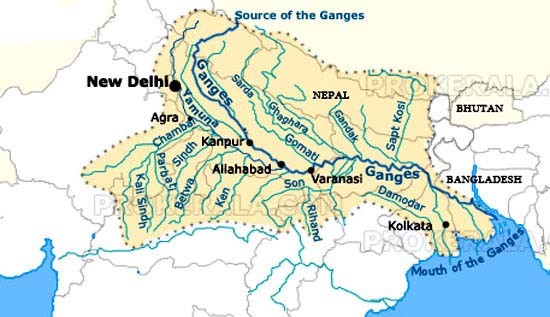
Why are these improvements only marginal?
- Reduction in BOD concentration has been less significant owing to continual discharge of untreated or inadequately treated sewage.
- Reduction in COD concentration has also been less significant while in a few locations show increase in the COD values and this marginal reduction can be attributed due to stoppage of industrial activities.
- Domestic wastewater from 97 towns situated near river Ganga, and industrial effluents, are the main sources of water pollution in the river.
- When it comes to sewage: out of an estimated quantity of 3,500 MLD (Million Litres per Day – only 1,100 MLD is treated and remaining 2,400 MLD gets discharged untreated.
- Industrial effluent is estimated to be about 300 MLD, which is about 9% of total wastewater being discharged into the river every day.
- Though projects worth ₹23,000 crore have been commissioned (across 11 Ganga basin States), a noticeable increase in the cleanliness of the river isn’t yet apparent.
The silver lining: The CPCB, however, said that there was notable improvement in water quality in the Yamuna.
Analysis results indicate there is considerable improvement in the water quality of river Yamuna with respect to DO, BOD and COD when compared with pre-lockdown and lockdown period.
Read More about CPCB and NMCG here:
https://www.legacyias.com/water-from-ganga-yamuna-being-tested/
ANIMAL POACHING REGISTERS A SHARP INCREASE DURING LOCKDOWN
Focus: GS-II Environment and Ecology
Why in news?
- The instances of poaching of wild animals and birds, including the endangered chinkara or Indian gazelle, have registered a sharp increase across Rajasthan during the COVID-19 lockdown, with the hunters taking advantage of slack monitoring and sparse public movement in the remote areas.
- Armed poachers have been moving inside the national parks and wildlife sanctuaries since the lockdown was enforced. Besides killing chinkaras and blackbucks, the poachers have targeted peacocks, grey francolins and other birds covered under the Wildlife Protection Act, 1972, as endangered species.
- Several of the cases were detected and reported to the forest authorities by the members of the Bishnoi community, which is known for its beliefs associated with nature worship and wildlife conservation.
- The chinkaras are usually poached in Rajasthan, allegedly by the Bawaria community, whose traditional occupation is hunting.
Chinkara, Indian Gazelle
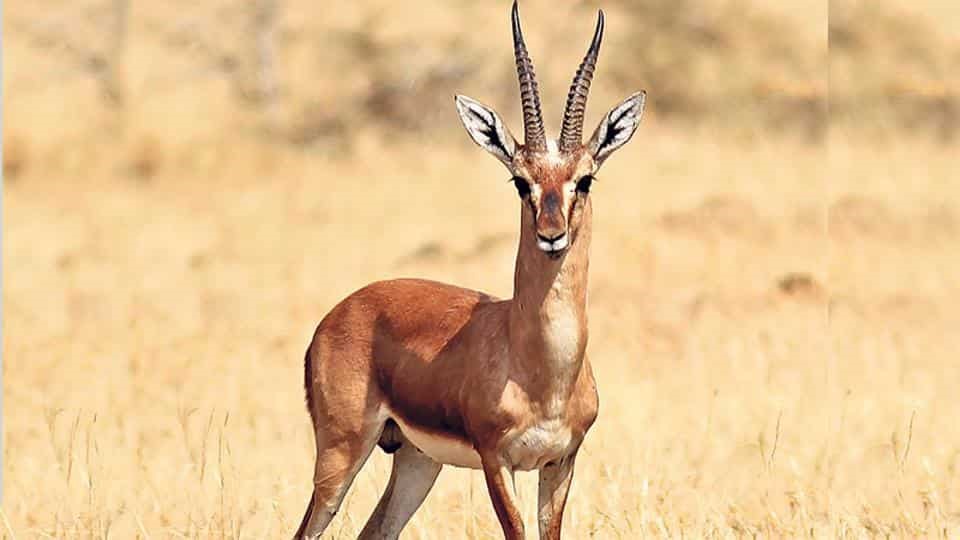
- The chinkara (Gazella bennettii), also known as the Indian gazelle, is a gazelle species native to Iran, Afghanistan, Pakistan and India.
- Chinkara live in arid plains and hills, deserts, dry scrub and light forests. They inhabit more than 80 protected areas in India.
- The chinkara is threatened by extensive hunting for meat and trophies in Afghanistan, Iran and Pakistan. Other threats include habitat loss due to agricultural and industrial expansion.
- IUCN Conservation Status: Least Concern
Blackbuck
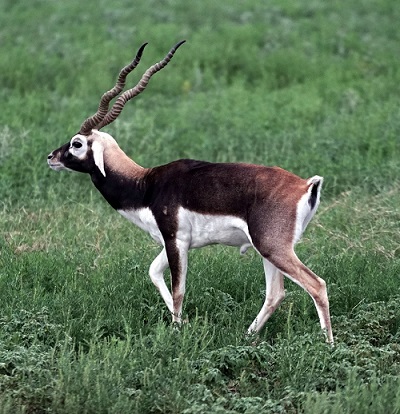
- The blackbuck (Antilope cervicapra), also known as the Indian antelope, is an antelope found in India, Nepal, and Pakistan.
- The blackbuck is the sole extant member of the genus Antilope.
- Blackbucks are native to the Indian subcontinent, but extinct in Bangladesh.
- Blackbucks inhabit grassy plains and thinly forested areas where perennial water sources are available for its daily need to drink, they travel long distances for water.
- During the 20th century, blackbuck numbers declined sharply due to excessive hunting, deforestation and habitat degradation.
- The blackbuck is listed under Appendix III of CITES.
- In India, hunting of blackbuck is prohibited under Schedule I of the Wildlife Protection Act of 1972.
- IUCN Conservation Status: Least Concern
Grey Francolin
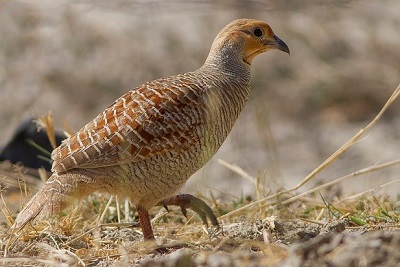
- The grey francolin (Francolinus pondicerianus) is a species of francolin found in the plains and drier parts of the Indian subcontinent.
- They are found in open cultivated lands as well as scrub forest and their local name of teetar.
- The distribution is south of the foothills of the Himalayas westwards to the Indus Valley and eastwards to Bengal.
- It is also found in north-western Sri Lanka. Introduced populations are found in the Andaman and Chagos Islands.
- IUCN Conservation Status: Least Concern




